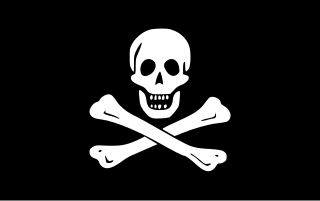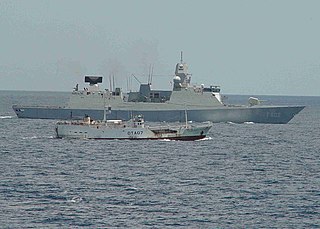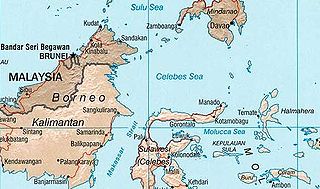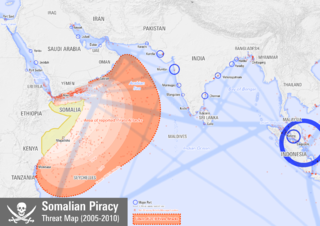
Piracy is an act of robbery or criminal violence by ship or boat-borne attackers upon another ship or a coastal area, typically with the goal of stealing cargo and other valuable goods. Those who conduct acts of piracy are called pirates, and vessels used for piracy are called pirate ships. The earliest documented instances of piracy were in the 14th century BC, when the Sea Peoples, a group of ocean raiders, attacked the ships of the Aegean and Mediterranean civilisations. Narrow channels which funnel shipping into predictable routes have long created opportunities for piracy, as well as for privateering and commerce raiding.

Piracy in the Strait of Malacca has long been a threat to ship owners and the mariners who ply the 900 km-long sea lane. In recent years, coordinated patrols by Indonesia, Malaysia, Thailand, and Singapore along with increased security on vessels have sparked a sharp downturn in piracy.

Maritime security operations (MSO) are the actions of modern naval forces to "combat sea-based terrorism and other illegal activities, such as hijacking, piracy, and slavery, also known as human trafficking." Ships assigned to such operations may also assist seafaring vessels in distress. These activities are part of an overall category of activities which fall short of open warfare called military operations other than war (MOOTW). MSO also involve the marine environmental protection, creating a safer and clean environment.

Piracy in the Gulf of Guinea affects a number of countries in West Africa as well as the wider international community. By 2011, it had become an issue of global concern. Pirates in the Gulf of Guinea are often part of heavily armed criminal enterprises, who employ violent methods to steal oil cargo. In 2012, the International Maritime Bureau (IMB), Oceans Beyond Piracy and the Maritime Piracy Humanitarian Response Program reported that the number of vessels attacks by West African pirates had reached a world high, with 966 seafarers attacked during the year. According to the Control Risks Group, pirate attacks in the Gulf of Guinea had by mid-November 2013 maintained a steady level of around 100 attempted hijackings in the year, a close second behind the Strait of Malacca in Southeast Asia.
Piracy off the coast of Somalia occurs in the Gulf of Aden, Guardafui Channel, and Somali Sea, in Somali territorial waters and other surrounding places and has a long troubled history with different perspectives from different communities. It was initially a threat to international fishing vessels during the early 2000s, only to rapidly escalate and expand to international shipping during the War in Somalia (2006–2009).

MV Faina was a roll-on/roll-off cargo ship operated by a Ukrainian company that sailed under a Belize flag of convenience, owned by Panama City-based Waterlux AG, and managed by Tomex Team of Odesa, Ukraine.

Mark Nicholas Gray MBE is a former colonel in the British Royal Marines, as of 2021 running a floating armoury company in the ocean area subject to piracy based in Somalia and nearby countries.
Piracy in Indonesia is not only notorious, but according to a survey conducted by the International Maritime Bureau, it was also the country sporting the highest rate of pirate attacks back in 2004, where it subsequently dropped to second place of the world's worst country of pirate attacks in 2008, finishing just behind Nigeria. However, Indonesia is still deemed the country with the world's most dangerous water due to its high piracy rate. With more than half of the world's piracy crimes surrounding the South-East Asia aquatic regions, the turmoil caused by piracy has made the Strait of Malacca a distinct pirate hotspot accounting for most of the attacks in Indonesia, making the ships that sail in this region risky ever since the Europeans arrived. The term 'Piracy in Indonesia' includes both cases of Indonesian pirates hijacking other cargo and tanks, as well as the high rate of practising piracy within the country itself. The Strait of Malacca is also one of the world's busiest shipping routes as it accounts for more than twenty-five percent of the world's barter goods that come mainly from China and Japan. Approximately 50,000 vessels worth of the world's trade employ the strait annually, including oil from the Persian Gulf and manufactured goods to the Middle East and Suez Canal. The success that stems from this trade portal makes the Strait an ideal location for pirate attacks.

Piracy in the 21st century has taken place in a number of waters around the world, including the Gulf of Guinea, Strait of Malacca, Sulu and Celebes Seas, Indian Ocean, and Falcon Lake.

The Sulu and Celebes Seas, a semi-enclosed sea area and porous region that covers an area of space around 1 million square kilometres, have been subject to illegal maritime activities since the pre-colonial era and continue to pose a maritime security threat to bordering nations up to this day. While piracy has long been identified as an ubiquitous challenge, being historically interwoven with the region, recent incidents also include other types of maritime crimes such as kidnapping and the trafficking of humans, arms and drugs. Attacks mostly classify as 'armed robbery against ships' according to the United Nations Convention on the Law of the Sea as they occur in maritime zones that lie under the sovereignty of a coastal state. Incidents in the Sulu and Celebes Seas specifically involve the abduction of crew members. Since March 2016, the Information Sharing Centre (ISC) of the Regional Cooperation Agreement on Combating Piracy and Armed Robbery against Ships in Asia (ReCAAP) reports a total of 86 abductions, leading to the issue of a warning for ships transpassing the area.

Operation Ocean Shield was NATO's contribution to Operation Enduring Freedom – Horn of Africa (OEF-HOA), an anti-piracy initiative in the Indian Ocean, Guardafui Channel, Gulf of Aden and Arabian Sea. It follows the earlier Operation Allied Protector. Naval operations began on 17 August 2009 after being approved by the North Atlantic Council, the program was terminated on 15 December 2016 by NATO. Operation Ocean Shield focused on protecting the ships of Operation Allied Provider, which transported relief supplies as part of the World Food Programme's mission in the region. The initiative also helped strengthen the navies and coast guards of regional states to assist in countering pirate attacks. Additionally, China, Japan and South Korea sent warships to participate in these activities.
AdvanFort is a US private maritime security company founded in 2009 and headquartered in Herndon, Virginia. It focuses on defense and homeland security products, technologies and services. Currently it has more than 100 employees and 200 contractors. In addition to groups of security teams working in several areas of the world and a fleet of operator support vessels in the Indian Ocean, the company has both a mission operations center and a threat analysis center. Until July 2013, it published weekly global piracy threat analysis, available without charge on its website.

The MV Seaman Guard Ohio is a floating armory ship owned by AdvanFort and used for storing weapons and security guards on private anti-piracy contracts. In October 2013, the ship was impounded and the crew and armed guards aboard were detained after it allegedly entered Indian waters with illegal arms without adequate permission.

Piracy in Somalia has been a threat to international shipping since the beginning of the country's civil war in the early 1990s. Since 2005, many international organizations have expressed concern over the rise in acts of piracy. Piracy impeded the delivery of shipments and increased shipping expenses, costing an estimated $6.6 to $6.9 billion a year in global trade in 2011 according to Oceans Beyond Piracy (OBP).
Piracy has taken place in a maritime area bounded by Suez and the Strait of Hormuz, in the region around the Horn of Africa, and waters surrounding the Arabian Peninsula; in the region of the Indian Ocean from the Red Sea through the Arabian Sea to the Gulf of Oman.
A Private Maritime Security Company (PMSC) is a form of Private Military Company that offers services in the maritime sector.
As a practice of piracy, petro-piracy, also sometimes called oil piracy or petrol piracy, is defined as “illegal taking of oil after vessel hijacks, which are sometimes executed with the use of motorships” with huge potential financial rewards. Petro-piracy is mostly a practice that is connected to and originates from piracy in the Gulf of Guinea, but examples of petro-piracy outside of the Gulf of Guinea is not uncommon. At least since 2008, the Gulf of Guinea has been home to pirates practicing petro-piracy by targeting the region's extensive oil industry. Piracy in the Gulf of Guinea has risen in the last years to become the hot spot of piracy globally with 76 actual and attempted attacks, according to the International Maritime Bureau (IMB). Most of these attacks in the Gulf of Guinea take place in inland or territorial waters, but recently pirates have been proven to venture further out to sea, e.g. crew members were kidnapped from the tanker David B. 220 nautical miles outside of Benin. Pirates most often targets vessels carrying oil products and kidnappings of crew for ransom. IMB reports that countries in the Gulf of Guinea, Angola, Benin, Cameroon, Equatorial Guinea, Ghana, Guinea, Ivory Coast, Togo, Congo, and, especially, Nigeria, have experienced petro-piracy and kidnappings of crew as the most common trends of piracy attacks in the Gulf of Guinea.
Piracy kidnappings occur during piracy, when people are kidnapped by pirates or taken hostage. Article 1 of the United Nations International Convention against the Taking of Hostages defines a hostage-taker as "any person who seizes or detains and threatens to kill, to injure, or to continue to detain another person in order to compel a third party namely, a State, an international intergovernmental organization, a natural or Juridical person, or a group of people, to do or abstain from doing any act as an explicit or implicit condition tor the release of the hostage commits the offense of taking of hostages ("hostage-taking") within the meaning of this convention." Kidnappers often try to obtain the largest financial reward possible in exchange for hostages, but piracy kidnappings can also be politically motivated.
2022 in piracy resulted in 115 reports of maritime piracy and armed robbery against ships to the International Maritime Bureau. 288 acts of global piracy and robbery were recorded by the MICA Centre. Piracy had substantially increased in the Gulf of Guinea; the year began with five incidents each month, through March, in the Gulf, where acts of piracy had become heightened during 2015 through 2020, while, overall, piracy incidents declined globally.










